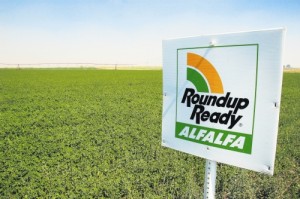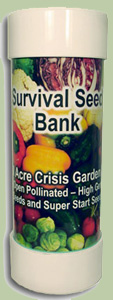Phillip Geertson has spent the last 30 years farming and raising many diversified crops, and has been a partner in alfalfa breeding programs for 25 years. Alfalfa is a perennial plant, which makes it extremely vulnerable to contamination.
 |
| Source |
Phillip Geertson
When Roundup Ready (hereafter “RR”) alfalfa was first suggested I did not think that it would be developed and introduced because most alfalfa fields are never sprayed for weed control. And, if a chemical weed control was needed, there is a long list of off-patent low-cost herbicides that are effective if used properly.
Alfalfa hay is usually cut on a schedule of 24 to 30 days for each crop harvest. The entire plant above ground is removed along with any weeds. This frequent cutting and removal suppresses weed growth and will control, and sometimes even eliminate, persistent perennials and noxious weeds that Roundup will not control.
 |
| Ad |
When alfalfa is properly fertilized and growing in appropriate soil conditions (correct Ph, well drained, etc.), alfalfa will outgrow and choke out most weeds. When alfalfa stands become weedy, non-thrifty, and otherwise poor performing it is usually because of poor fertility, insects, water logging, or winter damage. Weeds in an alfalfa forage field are a symptom of problems and simply spraying with Roundup to kill the weeds will not correct the underlying problem that is causing poor performance. A weedy alfalfa field should be plowed out, the soil conditions corrected, and then rotated to another crop that is not a host for alfalfa diseases, insects, or nematodes so that they die away. Afterwards, a new stand of alfalfa can be replanted.
Alfalfa is often planted with a companion crop of oats or other grasses in a spring seeding. The cover crop suppresses weeds and gives some protection to young alfalfa plants. An early summer cutting of the oats and new alfalfa plants produces valuable forage for horses, feeder cattle, and young dairy cattle. This practice, however, cannot be used with the RR technology because the Roundup will kill the oats or grass cover crop.
Forage fields of alfalfa are often planted with a companion perennial grass to produce forage that is an alfalfa-grass mix that is a superior feed for all classes of livestock. The grass component in the forage helps to balance the digestive process and gives a better balance of nutrients, so fewer supplements are required in high performance livestock. A grass mix forage is the best feed for horses and the grass in a dairy cow ration is very helpful in reducing laminitis in dairy cattle. Spraying an RR alfalfa field with Roundup will kill any companion grass.
The need for RR alfalfa is very limited; it only adds one more chemical to a long list of herbicides available.
From the standpoint of a conventional (non RR) alfalfa seed grower, the main problem with the introduction of RR alfalfa is the contamination of all alfalfa with the RR gene.
Alfalfa, a long-lived perennial, is cross pollinated by bees and other insects that fly long distances. Honey bees are known to fly ten miles, and wind gusts can pick up insects that have been pollinating alfalfa blossoms and gathering pollen and move them long distances.
Alfalfa sets and produces seed best if it is cross pollinated from another plant. If the pollen from an RR alfalfa plant fertilizes the flowers on a non-RR alfalfa plant, the seed on that non RR plant will contain the RR gene, and plants that grow from that seed will be roundup resistant. The RR gene will spread throughout the entire alfalfa population and would eventually make it impossible to raise conventional seed without some RR contamination and make it nearly impossible to breed and develop new varieties of alfalfa. This is not a good thing.
Conventional alfalfa contaminated with the RR gene will become a weed in the RR soybean, cotton, and sugar beet fields that cannot be removed.
Farmers that feel the RR technology is a valuable tool should and will avoid the introduction of any plant that is RR resistant . . . including alfalfa. The demand or acceptance of any conventional seed that has even a trace of RR contamination would be compromised, because a farmer who is growing other RR crops would not want his field contaminated with RR alfalfa.
Alfalfa is a native plant of Eurasia and grows as a feral plant throughout Europe. I have pictures of it growing along the Danube River in Austria, the Alps in Switzerland, and even in the median strip in front of the Nazi rally center in Nuremburg. It was introduced into North and South America, New Zealand, and Australia and other areas of the world where it now grows as a wild feral plant.
In a natural environment, the RR gene in alfalfa doesn’t give it any survival advantage. In fact, early yield trials show that alfalfas with the RR gene are poor performers. In the environment created by human activity, however, we have given RR alfalfa a survival advantage. The worldwide use of glysosphate (the active ingredient in Roundup and other generic herbicides) will give alfalfa plants with the RR gene a survival advantage over conventional alfalfa. There is no wonder that the rest of the world does not want RR alfalfa seed and have prohibited the import of any alfalfa seed contaminated with even a trace of the RR gene.
The U.S. Alfalfa seed industry was the world’s major producer of alfalfa seed. Historically, the U.S. alfalfa seed industry exported more than half of the alfalfa seed produced in the United States, but 2007 was the last time the USDA reported the size of the U.S. alfalfa seed exports. Why? Export data would be very useful in determining the amount of damage that was done to the U.S. alfalfa seed industry by the release of RR alfalfa into U.S. agriculture.
Alfalfa is the first important perennial plant to be genetically engineered and introduced into the environment that is cross pollinated by insects and that grows as a wild feral plant throughout the world. Putting a foreign gene that cannot be recalled into such an important crop without thoroughly analyzing its potential negative effects is, in my opinion, criminal. If Monsanto and/or other genetic engineering companies can get away with this introduction, then you can be sure that others will follow. Hundreds of other important plants will be subject to genetic mutation and if released into the environment could change the species forever. How does the Endangered Species Act come into play here?
Why was Monsanto given the right to introduce a gene into alfalfa plants without any published studies that prove beyond any doubt that it is safe, useful, and would not cause harm?
The timing of events: in 2004, Forage Genetics (hereafter “FG”) planted 5,332 acres of RR alfalfa for seed production.(This was more than one year before the USDA deregulated RR alfalfa in June 2005).
Then, in the spring of 2005, FG planted 5,468 more acres for seed production. Any plantings after June 2005 could not have produced any seed in 2005. 10,800 acres seems to be a lot of experimental acres that could have been planted BEFORE deregulation under the rules for experimental planting before deregulation. And, where did FG get the foundation RR seed to plant 5,332 acres in 2004?
That seed must have been grown and produced in 2003 or earlier, and had to be of significant size to plant 5,332 acres plus other experimental plantings.
In 2007, Paul Fry of Cal West Seed wrote a letter explaining the RR contamination Cal West found in seed lots produced in Montana and Washington during 2005. Those lots that were contaminated with the RR gene were planted with foundation seed produced in Solano County, California in 2003.
Therefore, it is obvious that FG/Monsanto allowed the RR gene to escape into the environment near the Cal West foundation seed fields in 2003.
It would be easy to determine where the contamination came from. All plantings of genetic crops not deregulated have to be registered with the USDA and with safeguards to prevent escape of the GM into the environment.
In the testimony given to the first RR court case and comments on the environmental impact statement, the so called “experts” claimed that the RR gene could be controlled so that there would be no contamination from the RR gene, but, in fact, the RR gene had already escaped in 2003 — two years prior to being deregulated for the first time in 2005. The USDA should be required to release all details of the experimental plantings prior to the June 2005 deregulation. Those records should detail how much, their locations, what precautions were taken to prevent escape of the mutant gene, who was responsible for the test, and who in the USDA approved it.
My own experience with exported alfalfa seed began in 1990 when I visited New Zealand and found that little alfalfa was used because of acid soils and the lack of rizobia bacteria.
After helping New Zealand farmers with better agronomic practices, alfalfa became a more widely used crop in New Zealand. And, over the next 20 years I developed a network of dealers to sell our U.S.-produced alfalfa seed varieties. We were poised to substantially expand our New Zealand seed sales until 2005 when New Zealand moved quickly to ban alfalfa that contained even a trace of the RR gene. At that time I had a field in Nevada contracted for alfalfa seed production that I intended to ship to New Zealand. It was tested for the presence of the RR gene and one test was positive. It would have been a bad business decision to ship the lot and hope the RR gene would not be detected.
Therefore, after 20 years of work, many trips to New Zealand, advertising costs, time and effort expended, we ended our New Zealand seed business. I knew there was no way to grow alfalfa seed that was free of RR contamination in the United States.
FG/Monsanto had contracted alfalfa seed production on 5,332 acres in 2004 and those acres were located in the middle of the major seed production areas of Montana, Wyoming, Colorado, Idaho, and Oregon.
Why?
Who will benefit because the U.S. alfalfa seed industry has lost most of its export market? International companies that own available varieties and have seed production facilities in other countries will benefit. FG/Monsanto and Pioneer International both own most of the alfalfa varieties and have production in Canada, Australia, and possibly elsewhere.
Phil Geertson is a conventional alfalfa seed grower who has been involved in efforts to stop genetically engineered alfalfa since 2003 resulting in a Supreme Court decision in 2010 on Forage Genetics/Monsanto’s engineered alfalfa.
RELATED ARTICLE:
‘No Food Rights’ Judge Quits to Work for Monsanto Law Firm
var linkwithin_site_id = 557381;
linkwithin_text=’Related Articles:’




Be the first to comment on "Roundup Ready Alfalfa Damages U.S. Seed Industry"